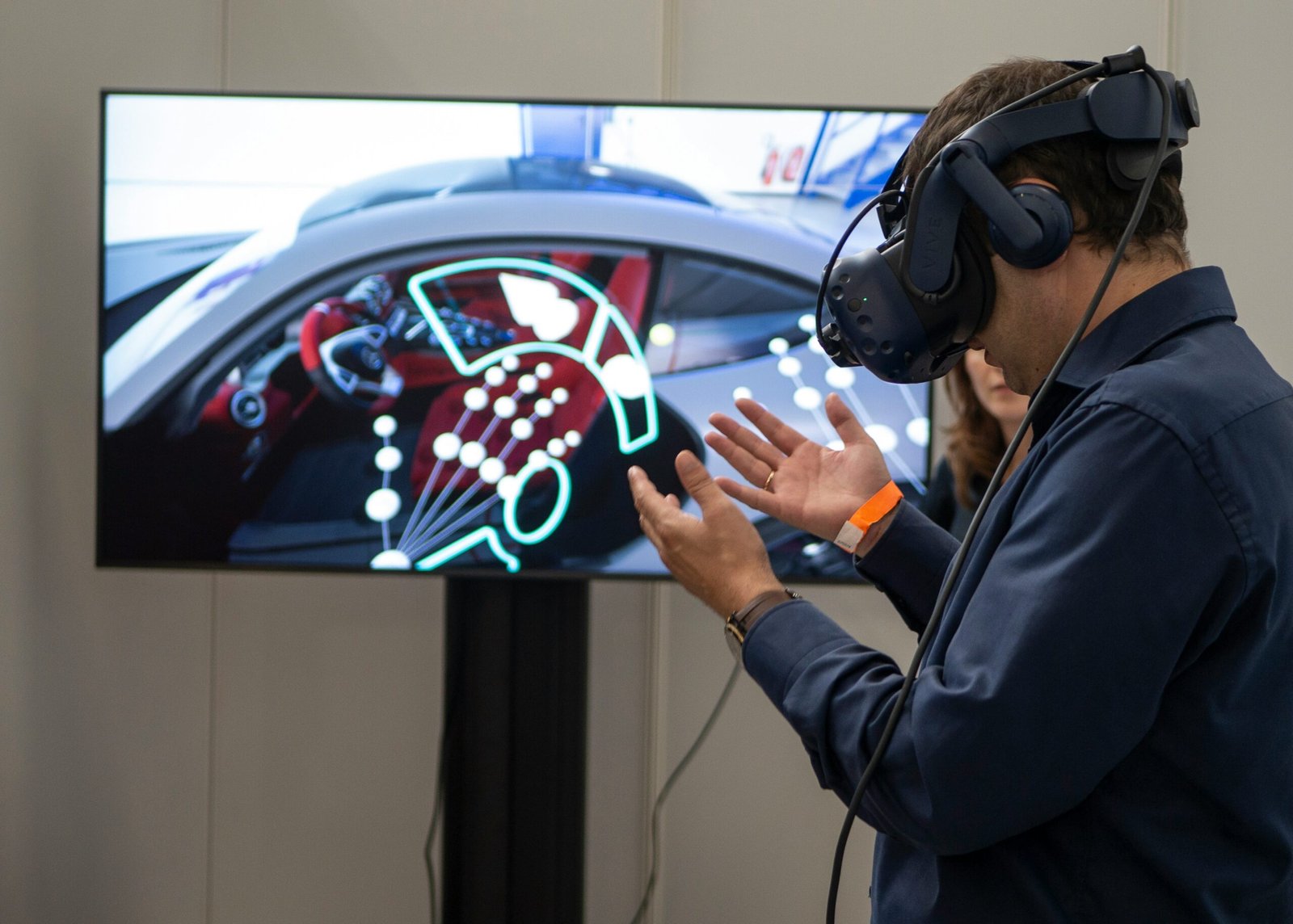Introduction to the Virtual World
The concept of the virtual world has evolved significantly in recent years, emerging as a profound aspect of our digital experience. It encapsulates the integration of technology into everyday life, influencing how we interact, learn, and express ourselves. In today’s rapidly advancing technological landscape, the virtual world serves not only as a space for entertainment and connection but also as a platform for profound scientific and philosophical exploration.
As we delve into the virtual world, we are presented with questions that challenge our perceptions of reality. What constitutes a real experience in an environment shaped by code and algorithms? Is our understanding of existence altered when we navigate digital realms that can simulate emotions and interactions? These inquiries invite us to explore the intersection of human experience and technological innovation, ultimately leading us to contemplate the implications of our growing reliance on virtual environments.
The significance of the virtual world extends beyond mere gameplay or social interaction; it is a realm where concepts like identity, community, and existence can be redefined. As immersive technologies such as virtual reality (VR) and augmented reality (AR) gain traction, they offer unparalleled opportunities to engage with information and perspectives that were previously unimaginable. This engagement prompts us to consider not only the technological aspects but also the philosophical questions that arise from our interactions within these environments.
In this article, we will embark on an exploration of the virtual world, examining its significance in both scientific and philosophical contexts. By embracing the profound questions it raises, we can better understand how these digital spaces challenge our perceptions and shape our future. Join us on this intellectual journey as we unravel the complexities of the virtual world and its impact on our understanding of reality.
The Definition of a Virtual World
A virtual world is a computer-generated environment that allows users to interact with one another and the surroundings, often in real-time. This immersive digital space is designed to simulate experiences or activities that can mimic or expand upon real-life interactions. Unlike traditional web applications, virtual worlds are characterized by their persistent nature, meaning that the environment continues to exist and evolve even when users are not actively engaged. This aspect creates a unique ecosystem where users contribute to the world’s narrative, economy, and social structures.
One of the key distinctions between virtual worlds and other digital environments, such as simple websites or 2D games, lies in their depth of interactivity. Virtual worlds typically provide three-dimensional spaces and avatars, enhancing the sense of presence and agency among users. This immersive quality allows for a more engaging experience, enabling users to form connections, create content, and experience scenarios that transcend geographical limitations. Virtual worlds can be found in various applications, ranging from gaming platforms like Second Life to training simulations used in industries such as aviation, medicine, and military.
Moreover, virtual worlds often incorporate elements of social interaction, where users can communicate, collaborate, or even compete with each other. This social dimension is crucial, as it fosters community building and shared experiences, often reflecting or amplifying real-world dynamics. Through avatars that represent users, individuals can engage in activities and pursuits that may not be possible in their physical environments. The capacity for creativity, invention, and exploration fundamentally transforms how users experience digital landscapes compared to non-immersive platforms.
The Evolution of the Virtual World
The virtual world has undergone significant transformation since its inception, influenced by technological advancements and cultural shifts. The journey begins in the early 1960s, when pioneering computer graphics were used to create the first rudimentary simulations. These early undertakings laid the groundwork for what would eventually evolve into complex virtual environments. One of the first notable milestones was the creation of the computer-based game “Spacewar!” in 1962. This marked the genesis of interactive digital experiences, sparking interest in the potential of computer-generated worlds.
As the 1970s progressed, advancements in graphical fidelity and processing power led to the development of more sophisticated systems. The introduction of personal computers in the 1980s opened digital creation to a broader audience, paving the way for early virtual worlds like “Habitat” and “The Well” in the late ‘80s and early ‘90s. These platforms allowed users to engage in social interactions within digital spaces, effectively blending gaming with social networking. The rise of the internet during this period was instrumental, fostering connectivity and enabling players to share their experiences across vast distances.
The emergence of virtual reality (VR) in the 1990s represented another significant leap forward. With devices like the Virtuality Group’s arcade machines and later, the Oculus Rift, the experience became immersive, providing users with the sensation of being present in a virtual environment. Concurrently, augmented reality (AR) began to gain traction, enabling digital information to overlay the physical world, as exemplified by innovations like Pokémon GO. These advancements have paved the way for increasingly complex and immersive experiences, engaging users in novel ways. The ongoing development in both VR and AR continues to expand the possibilities of the virtual world, signaling a future where these technologies will inevitably intertwine further with our everyday lives.
Scientific Perspectives on the Virtual World
The exploration of the virtual world through a scientific lens offers profound insights into its implications for human consciousness, perception, and interaction. Cognitive science, neuroscience, and computer science play pivotal roles in understanding how virtual environments intricately shape our experiences. One significant area of interest within cognitive science is the concept of presence, which refers to the psychological state of being immersed in a virtual environment. Research indicates that this sense of presence can significantly alter perceptions of reality, making individuals feel as though they are genuinely situated within a digital realm.
Neuroscience further elucidates how interactions with virtual worlds engage cognitive processes. Studies have demonstrated that virtual interactions can activate the brain’s reward systems similarly to real-life encounters. For example, research utilizing functional magnetic resonance imaging (fMRI) has shown that when individuals engage with virtual environments, areas of the brain associated with emotional responses and social interactions are activated. This suggests that even in the absence of physical presence, the brain processes virtual interactions as meaningful experiences, which can influence behavior and emotional states in the real world.
Computer science contributes to these findings through innovations in virtual reality (VR) technologies that enhance realism and interactivity. These advancements allow for more immersive experiences, leading to greater engagement with virtual content. Studies have shown that prolonged exposure to realistic virtual environments can affect individuals’ spatial awareness and cognitive mapping, reinforcing or altering their understanding of physical space. The interplay between the virtual and physical worlds raises essential questions about identity, agency, and the nature of human experience in the age of technology.
In evaluating the extensive body of research concerning the virtual world, it becomes increasingly clear that these environments have profound implications on human consciousness and behavior. By bridging scientific inquiry and philosophical contemplation, the discourse surrounding virtual experiences continues to evolve and expand. The insights gleaned from these scientific perspectives not only inform our understanding of technology but also our fundamental nature as conscious beings navigating an intricate digital landscape.
Philosophical Implications of Virtual Realities
The advent of virtual realities has ignited profound philosophical inquiries, challenging our longstanding perceptions of reality and existence. As individuals navigate these intricate digital landscapes, questions about the nature of being and consciousness arise. Philosophers have long debated the distinction between the ‘real’ and the ‘imagined’ or ‘virtual,’ positioning reality as a phenomenon dependent upon human perception. Notably, phenomenology, a branch focused on experiences, is particularly relevant here. It explores how individuals interpret and derive meaning from their experiences, whether real or virtual.
One of the central philosophical questions posed is: what constitutes reality? In a virtual world, sensations and interactions can mimic those of the real world, leading to a unique perspective on existence. This inquiry often leads back to René Descartes’ famous arguments concerning consciousness and doubt. His assertion “Cogito, ergo sum” suggests that the ability to think provides conclusive evidence of existence, compelling one to contemplate existence in both physical and virtual realms. As individuals engage and interact within these digital environments, they contribute to a layer of existence that merits recognition.
The moral considerations surrounding interactions in virtual spaces also merit attention. Are actions carried out in a virtual world devoid of consequence? The ethical frameworks that govern real-life interactions are increasingly applied to virtual engagements, suggesting that virtual behavior can have tangible impacts. This raises further questions regarding our responsibilities to others in these simulated realities. It echoes the theories of Immanuel Kant, who argued for a moral imperative that respects the autonomy of rational beings—an idea that transcends both physical and virtual boundaries.
Ultimately, the philosophical implications of virtual realities compel us to reassess our understanding of existence, ethics, and the nature of reality itself. As technology continues to evolve, so too will our philosophical inquiries, emphasizing the need for critical reflection on our interaction with virtual spaces.
Real-Life Applications of Virtual Worlds
Virtual worlds have emerged as transformative tools across various sectors, particularly in education, therapy, and training. These digital landscapes not only simulate real-life environments but also enable innovative methods for engagement and learning. One notable example is in the field of education, where institutions have begun integrating virtual reality (VR) into their curricula. Programs like the Virtual Reality Education Pathways initiative provide students with immersive experiences that deepen their understanding of complex subjects. For instance, biology students can explore the intricate details of cellular structures in a 3D space, enhancing visual learning and retention.
In therapy, virtual worlds have shown remarkable efficacy in addressing psychological conditions such as anxiety and post-traumatic stress disorder (PTSD). The Exposure Therapy for PTSD program utilizes virtual environments to expose patients to triggering scenarios in a controlled manner. Through gradual and repeated exposure, individuals can confront their fears within the safety of a virtual space. This method not only aids in the desensitization process but also allows therapists to monitor patient reactions closely, tailoring interventions to individual needs.
Moreover, training simulations in various industries leverage virtual worlds for skill development. For example, the use of VR in healthcare training has gained traction, enabling medical students to practice surgeries in a risk-free environment. Institutions like the University of California, Irvine, have implemented VR surgical training modules that provide realistic scenarios, allowing students to make mistakes and learn from them without jeopardizing patient safety. Similarly, in the aviation sector, pilots undergo extensive training in flight simulators that replicate the complexities of real-world flying, significantly reducing training costs while improving preparedness.
These concrete applications underline the versatility and potential of virtual worlds in real-life contexts, highlighting their role in enhancing learning processes and therapeutic interventions across diverse sectors.
Challenges and Limitations of Virtual Worlds
The advent of virtual worlds has revolutionized how individuals interact, learn, and experience entertainment. However, these immersive digital spaces are not without their challenges and limitations. One significant concern is accessibility. While technology has advanced rapidly, not all individuals can access virtual environments due to economic barriers, lack of technological infrastructure, or disabilities. This creates a disparity where only certain demographics can fully experience the advantages of virtual worlds, potentially leading to broader societal divides.
Another pressing issue is addiction. As virtual environments become more engaging and rewarding, some users may find themselves increasingly drawn into these spaces at the expense of their real-life responsibilities. This potential for addiction can disrupt personal relationships, impact mental health, and diminish overall well-being. Users may lose touch with reality, leading to significant consequences for both individuals and their families.
Ethical concerns also arise in the context of virtual worlds. Questions regarding data privacy, user consent, and the potential for exploitation in virtual economies are critical in evaluating the safety of these environments. Moreover, the portrayal of violence, discrimination, and other negative behaviors in some virtual spaces can contribute to harmful social norms, influencing behaviors and attitudes in real life. As such, the ethical implications of virtual worlds demand thorough examination and regulation to safeguard users.
These challenges not only affect individual users but may also have broader societal implications. As virtual worlds continue to grow, it is essential for stakeholders, including developers, educators, and policymakers, to critically evaluate their impact. By addressing these limitations and implementing strategies to mitigate risks, stakeholders can ensure that virtual worlds enhance rather than detract from the human experience.
The Future of the Virtual World
As we look toward the future, the potential advancements in technology that could redefine the virtual world are both exciting and complex. Innovations in areas such as artificial intelligence (AI), augmented reality (AR), and virtual reality (VR) are set to enrich user experiences beyond our current imagination. AI, for instance, is already playing a crucial role in creating more immersive environments and personalized interactions within virtual spaces. By utilizing machine learning algorithms, virtual worlds can adapt in real-time to user behaviors, providing tailored experiences that align closely with individual preferences.
Moreover, the integration of augmented reality is expected to blur the lines between the physical and digital realms, offering seamless interactions with virtual elements embedded in our everyday lives. This fusion could lead to new applications in education, training, and entertainment, enhancing engagement and retention. Picture classrooms that utilize AR to visualize complex theories or training simulations that create realistic environments for skill development. The implications are profound as we tap into multi-sensory experiences that can significantly augment learning and engagement.
On the social front, the future of the virtual world presents both opportunities and challenges. As more individuals gravitate toward digital interactions, issues surrounding privacy, security, and the nature of human connections in virtual spaces will come to the forefront. The potential for creating communities within these realms offers an avenue for unprecedented collaboration and interaction, yet it raises questions about the authenticity of these relationships and their impact on real-world connections.
In conclusion, as we venture deeper into the virtual world, it is crucial to understand the underlying technologies shaping these experiences. The continued evolution of AI, AR, and VR, along with thoughtful societal discourse, will be essential in navigating the complexities of our increasingly digital lives. The future holds a promise of enriched experiences that can transform not only how we interact but also how we perceive our reality.
Conclusion
Throughout this exploration of the virtual world, we have unpacked its profound impact on both science and philosophy. The significance of virtual environments extends beyond mere entertainment or digital interaction; they represent an evolving domain that prompts key questions regarding our perception of reality, ethics, and human cognition. The interconnection of virtuality with scientific inquiry offers new methodologies for research and understanding, enabling scientists and philosophers to question the very foundations of knowledge itself.
In contemplating the philosophical implications, we must consider concepts such as existentialism, realism, and constructivism in the context of virtual experiences. These frameworks assist us in questioning how our perceptions are shaped by digital interfaces and simulated realities. Furthermore, as we delve into the social and ethical considerations surrounding virtual worlds, the increasing prevalence of immersive technologies obligates us to confront dilemmas regarding identity, privacy, and agency in these platforms.
Additionally, the rapid advancement of artificial intelligence and virtual reality serves as a catalyst for further dialogues surrounding the nature of consciousness and the limits of human experience. As we gaze into the horizon of technological progress, it is crucial to ask: What does the future hold for virtual realms, and how will they influence our understanding of what it means to exist? Will these technologies bind us or liberate us from the constraints of our physical realities? The ongoing evolution of virtual worlds demands not only our attention but a commitment to engage in a deeper discourse about their implications.
Ultimately, as we navigate this intricate interplay between science, philosophy, and the virtual realm, it is evident that our exploration is far from finished. The questions raised in this article serve as a foundation for an enduring conversation about the impact of the virtual world on modern life, urging readers to consider their own role and experiences within this rapidly changing landscape.






